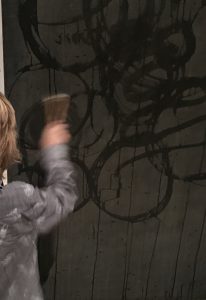Somatic Pedagogy
Resource Guide

How to Turn of Notifications on Your Computer
- For Windows 10, see: https://www.digitaltrends.com/computing/how-to-turn-off-notifications-in-windows-10/
Grounding Exercise
I’ll invite you to join me in a 5-minute grounding exercise. We will bring attention to our physical comfort in this Somatic Experiencing technique. We’ll take our time with each step. This exercise is designed for sitting in a chair, so if you can do that, please do. If not, no problem, just adjust the suggestions according to your situation.
- I invite you to turn off your camera for this exercise.
- Please begin by taking a moment and notice your overall somatic experience. What’s happening in your body right now?
- Move your feet on the floor, moving and shifting until you really feel connected to the floor.
- Now feel your body on the chair, noticing the weight of your body settling down and how the chair supports you. (Ask yourself if you are perching on the chair? If so, allow the chair to support you.)
- Adjust until you feel as comfortable as possible. Take a few moments to really enjoy the comfort of being supported by the chair and stabilized by the floor.
- Look around and take a breath in. Notice something that you feel positively toward. Is there a nice smell around you, a tree outside the window, a piece of art, a calming color, a nice grain to the wood floor, a favorite book on the shelf, etc.). Sit with the positive sensation that you are experiencing.
- Imagine or visualize the positive sensations that you feel. Does the sensation have have a color? Shape? Temperature — Warm or Cool? Does it move or remain still in your body?. Just take a moment to be with that sensation.
- Now, bring your focus back to your body as a whole. What do you notice now about your overall comfort – physically and emotionally?
Adapted from: “5 Somatic Experiencing Exercises to Keep Grounded During Coronavirus Uncertainty – Life Care Wellness” https://life-care-wellness.com/somatic-experiencing-exercises-to-keep-you-grounded/
References & Resources
hooks, bell. 1994. Teaching to Transgress: Education as the Practice of Freedom. New York: Routledge.
———. 2003. Teaching Community: A Pedagogy of Hope. New York: Routledge.
Imad, Mays. 2020. “Seven Recommendations for Helping Students Thrive in Times of Trauma | Inside Higher Ed.” June 3. Accessed October 26, 2020. https://www.insidehighered.com/advice/2020/06/03/seven-recommendations-helping-students-thrive-times-trauma.
Levine, Peter A., and Gabor Mate. 2010. In an Unspoken Voice: How the Body Releases Trauma and Restores Goodness. Illustrated Edition. Berkeley: North Atlantic Books.
Porges, Stephen W. 2011. The Polyvagal Theory: Neurophysiological Foundations of Emotions, Attachment, Communication, and Self-Regulation. Illustrated Edition. New York: W. W. Norton & Company.
Shimamoto, Kate. 2020. “Implementing Relational Pedagogy in the Form of 15 Minute Chats” Unpublished, informal blog post. Available via Adobe file share at: https://documentcloud.adobe.com/link/track?uri=urn:aaid:scds:US:d600467c-7360-43b1-92de-e3925d7ad51f
“Somatic Experiencing – Continuing Education.” Accessed October 25, 2020. https://traumahealing.org/.
Wagner, Anne E., and Riyad A. Shahjahan. 2015. “Centering Embodied Learning in Anti-Oppressive Pedagogy.” Teaching in Higher Education 20 (3): 244–54. https://doi.org/10.1080/13562517.2014.993963.
“WHITE SUPREMACY CULTURE: Characteristics.” n.d. Showing Up for Racial Justice – SURJ. Accessed October 23, 2020. https://www.showingupforracialjustice.org/white-supremacy-culture-characteristics.html.

